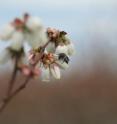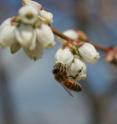Researchers develop system for assessing how effective species are at pollinating crops
From tomatoes to pumpkins, most fruit and vegetable crops rely on pollination by bees and other insect species -- and the future of many of those species is uncertain. Now researchers from North Carolina State University are proposing a set of guidelines for assessing the performance of pollinator species in order to determine which species are most important and should be prioritized for protection. "Widespread concerns over the fate of honey bees and other pollinators have led to increased efforts to understand which species are the most effective pollinators, since this has huge ramifications for the agriculture industry," says Dr. Hannah Burrack, an associate professor of entomology at NC State and co-author of a paper on the new guidelines and related research. "However, various research efforts have taken a wide variety of approaches, making it difficult to compare results in a meaningful way.
"We've developed a set of metrics that we think offers a comprehensive overview of pollination efficiency, which would allow researchers to compare data from different crops and regions."
The new comprehensive approach looks at four specific metrics. First is single-visit efficiency, which measures the number of seeds produced when one bee visits one flower. Second is abundance, which measures the number of each type of bee observed in a study area. Third is inclement weather behavior, which tracks how active a bee species is during cool, cloudy and/or windy weather. Fourth is visitation rate, or the number of flowers that a bee visits while foraging, and the amount of time it spends at each flower.
"The perfect bee would produce a lot of seeds and visit a lot of flowers, even in poor weather -- and there would be a lot of them," Burrack says. "But as far as we know, the perfect bee doesn't exist."
The researchers conducted a pilot study using their comprehensive approach to assess the pollination performance of various bee species on economically important highbush blueberry crops in North Carolina. They found that small native bees had extremely high single-visit efficiency rates and were active during inclement weather. However, small native bees did not have high abundance nor appear to have high visitation rates.
"This highlights the importance of incorporating multiple metrics," says Dr. David Tarpy, an associate professor of entomology at NC State and co-author of the paper. "Because researchers looking only at visitation rates or abundance may think the small native species are unimportant, when they actually appear to be important pollinators for blueberry growers."
The paper, "Multiple Criteria for Evaluating Pollinator Performance in Highbush Blueberry (Ericales: Ericaceae) Agroecosystems," was published online Nov. 25 in the journal Environmental Entomology.
Source: North Carolina State University
Other sources
- System developed for assessing how effective species are at pollinating cropsfrom Science DailyMon, 9 Dec 2013, 19:30:43 UTC
- Researchers develop system for assessing how effective species are at pollinating cropsfrom PhysorgMon, 9 Dec 2013, 16:30:16 UTC

